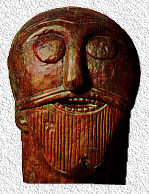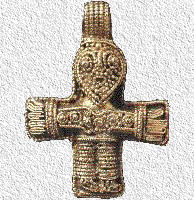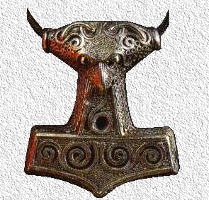

The Æsir cult was the prevailing religion in Scandinavia during the Bronze Age, the Iron Age and the Viking Age.
But it was not always possible for men to travel by water either, first of all, you needed something to do it in, a ship for example, and let's put a dragon-head in the steam so it will spread dread and keep those dangerous stuff away. Just for safety!
WELL, what I want to point at, and explain here, is that it wasn't all men that were "vikings" and travled around looking for fortune. Almost all men were farmers, and in addition to that they were seamen, and some were merchants or had another way of making his living back then. Therefore, ideas and thoughts spread slowly, and didn't reach all places.
It was the Christians, um well, it was Snorri Sturluson, who studied the old Icelandic charms and stories and then united them into one little "Bible" - called the Prose Edda and which has made people of today think of the old Nordic folkbelief as a religion.
This is also the reason why many of the Æsir are called "the wisest" or "the strongest" or "the God of war". All the Æsir are strong and wise, but hey, three of them can't possibly be the strongest...
This is why I believe every attempt to unite the Æsir cult and all that it consists (WITHOUT EDITING IT) is doomed to fail.
Many people seems to prefer the Icelandic word for the Æsir cult - Asatru, but that seems weird to me, as the "asatru" wasn't more Icelandic than Norweigan, Swedish or Danish. This confusion probably depends on the fact that Snorri Sturluson - who wrote the Prose Edda - was from Iceland.
One of the most important trading-centres in the whole of Scandinavia, during this time, was Birka, situated in Björk-island, Lake Mälaren, where Stockholm, the capital of Sweden, is situated today.
Ansgar and Witmar stayed in Birka for 1 ½ year, and then they returned back to Germany the year 831.
Soon the inhabitants of Birka started a big tumult against Christianity and they burned Hergeir's church, and killed the Christians...
Now Sweden remained a pagan country for nearly 150 years. The Swedes started to trade with the East, and therefore, all contact with Christianity ended. The other Scandinavian countries, Iceland, Norway and Denmark, traded to the West and they slowly got more and more influenced by Christianity and around the year 1000 AD, they were all Christians. Sweden was the only one left... The first Swedish King who let himself be Christen, was Erik Segersäll
Even though Sweden became a Christian country, the people sacrificed to the old gods whenever something bad happened, like failure of the crops, storms, fire or enimies...
And the old gods, myths and traditions were kept alive by the people and some of them are still in use today...
Well, it isn't really correct to call it a religion, as it had nor churches or priests. It was more like a folkbelief, kept alive by exciting sagas and legends about heroic men and Gods, evil Trolls and Giants, Dragons and other mysterious beings. It gave answers to the big questions in life and gave help in times of trouble and misfortune.
The Æsir cult was different in every village, the foremost As or Asynja switched from place to place...
For more than one thousand years ago, Scandinavia was covered by dark forests and cold fiells and mountains between the fiords. The only place where it was possible for people to live was along the shores. The only way to get from one place to another in those days was by water, only a fool would be stupid enough to go into those inhospitable woods filled with wolves, bears and who knows what scary beings???
Hey, everybody had heard the rumours of the Mountain Trolls who stole newborns, about the Vätts, those small ones living beneath the surface of the earth and who enjoyed casting evil spells upon people.  Let us not forget the Creek-horse or the Nude one - these dark powers of the forest-tarns and other waters which would twist the mind of the wisest and make him drown in the tiniest puddle.
Let us not forget the Creek-horse or the Nude one - these dark powers of the forest-tarns and other waters which would twist the mind of the wisest and make him drown in the tiniest puddle.
Ohno - I wouldn't travel by foot in the woods - the stories are to many and by Thor, haven't I seen some of this myself???
Then you needed money enough to get the men you wanted and then - not to forget - you needed time! A man, if he were to be called a man, had his own farm and family. The man was in charge of all this, he couldn't just leave his poor woman and small children alone - keep in mind - these days were dangerous for all!
They had to have food enough for the time he was away, he had to make sure some other men guarded his property for him and also make sure they didn't seduce his wife. It wasn't so easy - just to leave like that!
Believe it or not, but it did live people in the woods, may Odin keep a watching raven-eye upon them, inspite of the horrible rumours. These wood-men were very isolated, and still were until the beginning of the 1900's. That is one of the reasons the runes survived for so long in the dark and thick forests of middle-Sweden.
Because of this, the Æsir cult switched from place to place, and had small variations from one village compared to it's neighbours.
;-)
 King Björn (Bear) wanted missionaries from Europe to come, because there were always many foreign, Christians merchants in Birka and the arrival of missionaries would benefit the trade between Birka and the Christian Europe. Sent from Germany were the monks Ansgar and Witmar. They were well received and the King gave them permission to teach their new faith and he gave anyone permission to try it. Birka's centurion, Hergeir, who also was the King's most beloved advisor, let himself be Christian and he then built his own church in Birka.
King Björn (Bear) wanted missionaries from Europe to come, because there were always many foreign, Christians merchants in Birka and the arrival of missionaries would benefit the trade between Birka and the Christian Europe. Sent from Germany were the monks Ansgar and Witmar. They were well received and the King gave them permission to teach their new faith and he gave anyone permission to try it. Birka's centurion, Hergeir, who also was the King's most beloved advisor, let himself be Christian and he then built his own church in Birka.

The north part of Sweden didn't want to let go of the Ęsir cult for many years but they didn't have much choice...